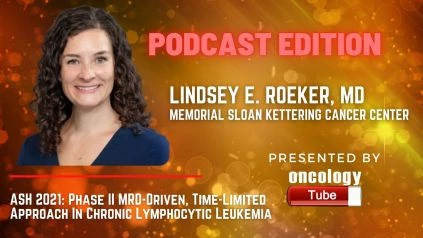Lindsey E. Roeker, MD Hematologist Oncologist from Memorial Sloan Kettering Cancer Center speaks about the ASH 2021 Abstract – A Phase 2 Study Evaluating the Addition of Ublituximab and Umbralisib (U2) to Ibrutinib in Patients with Chronic Lymphocytic Leukemia (CLL): A Minimal Residual Disease (MRD)-Driven, Time-Limited Approach.
Link to Abstract:
https://www.sciencedirect.com/science/article/abs/pii/S0006497121023892#!
AÂ summary –
Context:
While time-limited new agent combinations have shown good overall response rates and long-term responses in patients with chronic lymphocytic leukemia (CLL), they also have a high rate of adverse events and may overtreat many patients who are at low risk. Patients on indefinite ibrutinib monotherapy, on the other hand, are at risk of cumulative toxicity and developed resistance as a result of their continued exposure. After a period of ibrutinib monotherapy, we used an “add-on” strategy to combination therapy to address these issues. After an initial period of treatment with ibrutinib monotherapy, we looked at adding umbralisib (a selective PI3K and casein kinase-1epsilon [CK1] inhibitor) and ublituximab (a novel anti-CD20 monoclonal antibody glycoengineered for enhanced antibody-dependent cellular cytotoxicity; U2) to ibrutinib in CLL patients with detectable minimal residual disease (MRD). We hoped to achieve undetectable MRD (uMRD), reduce the chance of BTKi resistance mutations, terminate all CLL-directed therapy, and achieve a long treatment-free observation (TFO) time in CLL patients who would benefit most from combination therapy with this technique.
Methodologies:
This is a multicenter, phase II, open-label clinical investigation (NCT04016805). Patients are required to be on ibrutinib for at least 6 months in any line of treatment and have detectable residual CLL in the peripheral blood by MRD assay (flow cytometry with a threshold of 10-4 for uMRD). Ibrutinib was combined with umbralisib (800 mg daily) and ublituximab (900 mg intravenously on Days 1/2 [divided 150/750 mg], 8, and 15 of Cycle 1, Day 1 of Cycles 2-6, and on Day 1 every 3 cycles after Cycle 6) and patients were serially assessed for MRD beginning on Cycle 3 Day 1. Patients entered a term of TFO once uMRD was attained and confirmed 4 weeks later. Patients who did not achieve uMRD were treated for up to 24 cycles before receiving TFO. The study’s main goal was to determine the rate of uMRD conversion, with a 25% MRD conversion rate being considered promising. Safety and the persistence of clinical improvement following therapy termination were secondary objectives.
Outcomes:
U2 was introduced to ibrutinib in 26 patients in this fully accrued study. The median age was 63 years (range: 48-81) and 77 percent of the participants were men. Del(17p) was found in 8% of cases, del(11q) was found in 12% of cases, and unmutated IGHV was found in 31% of cases. Prior to the addition of U2, the median duration of ibrutinib treatment was 22 months (range 7-66 months). Figure 1 shows the time spent on ibrutinib previous to entering in this trial, the duration of triplet therapy, the accomplishment of uMRD, and TFO.
In 24 patients with MRD, 71 percent (17/24) exhibited uMRD in at least one examination. The median time it took to get the first uMRD result was 5 months (range 2 – 12). Sixteen patients (67%) began TFO; 15 had two consecutive uMRD evaluations, and one completed 24 cycles with measurable MRD. As of the data cutoff, TFO appeared to be long-lasting, with a median of 242 days off medication (range 5-538 days). At the final follow-up, 73 percent were still uMRD. According to the iwCLL criteria, no patient has progressed or required re-treatment.
The combination of U2 and ibrutinib was well tolerated. ALT/AST rise (4%), diarrhea (4%), and hypertension (4%), all of which were all-causality grade 3/4 adverse events of particular relevance (8 percent ). Due to rash, two patients stopped all therapy; both were uMRD at the time of treatment withdrawal and are still uMRD. COVID-19 problems resulted in the death of one patient.
Findings:
The combination of BTKi, PI3Ki, and anti-CD20 monoclonal antibody is the first MRD-driven method. This novel agent combination therapy was well tolerated and successful, with 71% of evaluable patients achieving uMRD. For patients on continuous ibrutinib, this “add-on” approach resulted in deep remissions, allowing for personalized, time-limited therapy and long periods of treatment-free observation.

